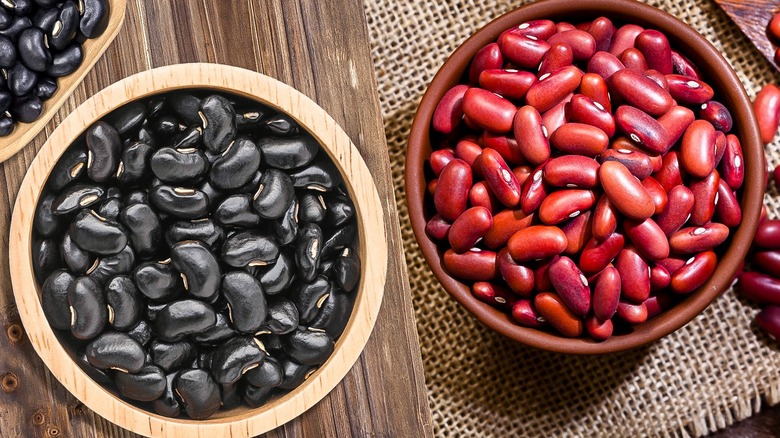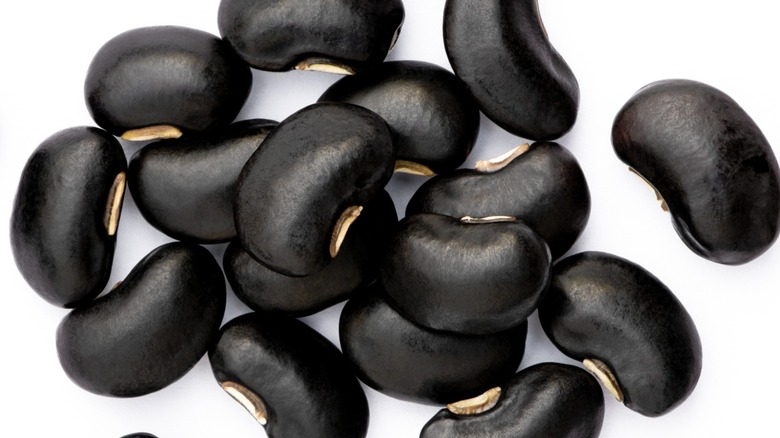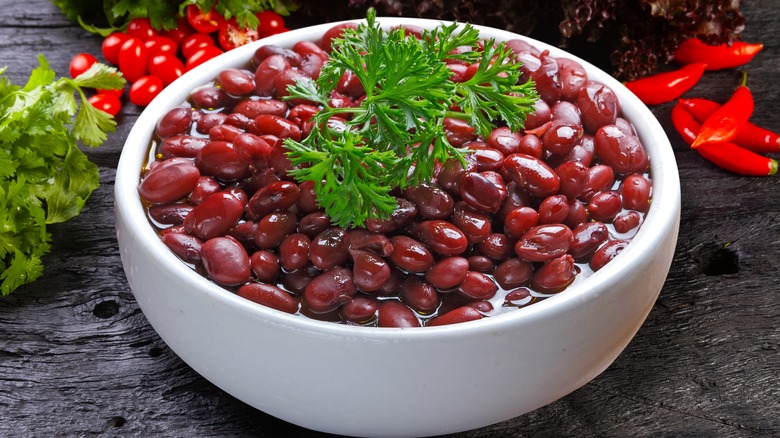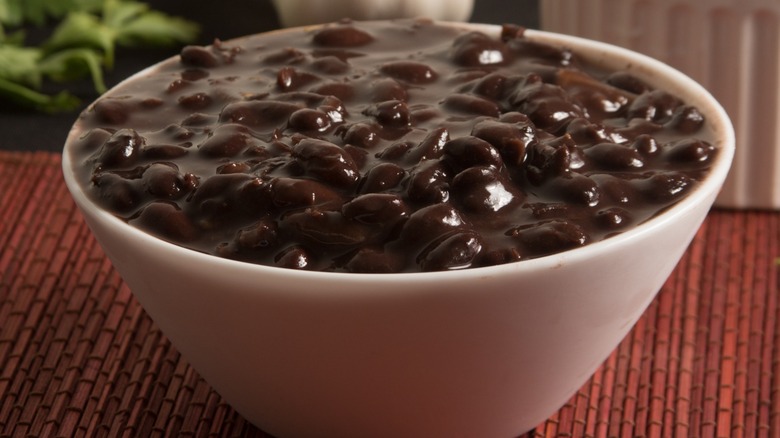The Biggest Differences Between Black Beans And Kidney Beans
Every kitchen would benefit from having a stock of beans in the pantry. Despite their propensity for causing flatulence, they're nutritious, economical, and versatile ingredients. Their culinary significance dates back thousands of years, with evidence indicating that indigenous Mexicans and Peruvians were cultivating them for food as early as 7,000 B.C. Rich in protein, dietary fiber, and folate, these members of the legume family are classified as superfoods, so regardless of what type of bean you're cooking, you can expect to end up with a highly nutritious dish.
What you might consider when selecting the kind of beans you want to use, though, is their flavor, texture, and the color they will impart to a dish. You'd also need to take into account how each type must be cooked and for how long. Not only do proper cooking procedures bring out the beans' best flavor, but they also reduce the amount of antinutrients present in them. Antinutrients are compounds that make these legumes difficult to digest when not fully cooked, and they also inhibit the body's absorption of certain crucial nutrients.
Two popular bean varieties are black beans and kidney beans. A good reason to choose either of them is their higher antioxidant activity due to their dark seed covers. However, swapping one for the other isn't advised since one considerable difference between them is their required cooking time. To enjoy the full benefits of both black and kidney beans, it's best to know how one is distinct from the other.
What are black beans?
A culinary staple in various countries, black beans go by different names. Turtle beans, caviar criollo, and frijoles negros all refer to this variety, and as the name implies, they have a matte black coating with distinctive white dots or slivers at the center. Typically measuring around half an inch in length, they have a subtle boat-like shape.
When cooked, these legumes take on a soft and velvety texture that works really well in a wide array of dishes; check out the 15 recipes we recommend using when cooking black beans. Black beans also maintain their shape when cooked, which makes them great additions to salads, as well. When processed further, they function as binding agents with their rich creaminess. This quality also makes them ideal for making vegetarian patties and meatballs.
In terms of flavor, they are mildly sweet and can even be used to make desserts creamier. Aside from the protein and dietary fiber they offer, black beans are rich in flavonoids, specifically anthocyanins, which are the source of these legumes' dark coating. Plant-derived anthocyanins have great potential to be developed into pharmaceutical ingredients because of their antidiabetic, anti-inflammatory, and antimicrobial effects, among others.
What are kidney beans?
With a distinct kidney-like shape that gives them their name, kidney beans typically have a vivid deep red color that makes them a great visual addition to a dish, although you can also find white, brown, and speckled varieties. People tend to wonder whether kidney beans and red beans are the same thing, but they are two distinct beans.
Originating from Peru, where they were first cultivated 8,000 years ago, kidney beans are now a staple in different culinary cultures worldwide. They make dishes heartier with their firm yet creamy texture and mildly nutty, earthy flavor. They also take on the flavors of the other ingredients they're simmered with, plus their slightly thicker skin helps them hold their form well despite long hours of cooking.
When it comes to nutritional content, this bean type contains as many antioxidants as blueberries. Kidney beans are also one of the few food items that are included in two food groups due to the high amounts of protein and minerals they offer.
Kidney beans can be toxic when not cooked properly
As healthy and economical as beans are, they require prep work to become edible. In the case of kidney beans, it could be dangerous not to cook them properly due to a specific antinutrient. Lectins such as phytohaemagglutinin (PHA) are toxic compounds found in negligible amounts in most types of dried beans that are consumed in the U.S., but they show up in concentrated levels in kidney beans.
In plants, PHA functions as a defense mechanism by binding sugars. When ingested by humans and other mammals, it can attach itself to the intestinal walls and induce nausea, cramping, vomiting, and diarrhea. Prolonged consumption of or exposure to PHA may increase the risk of malnutrition, poor health, and contribute to conditions like rheumatoid arthritis. It is not advised to cook raw beans in a slow cooker. Studies have shown that this kitchen equipment doesn't reach the temperature needed to destroy the toxin.
Slow cookers reach an internal temperature of only 167 degrees Fahrenheit, whereas PHA needs to be exposed to 212 degrees Fahrenheit for a minimum of 10 minutes to be neutralized. Thus, it's best to use the stovetop or oven when making a kidney bean-based dish to ensure that the legumes are fully cooked and safe to eat. If you have to use a slow cooker, put the kidney beans to boil on the stovetop first for 10 minutes. Drain and then rinse them before adding them to your slow-cooked dish.
Black beans require a shorter cooking time
Black beans have thinner skins compared to the hardier kidney beans, which means they can be cooked in a slow cooker safely. They also cook much faster, requiring only 60 to 90 minutes. Kidney beans, on the other hand, must be cooked for 90 to 120 minutes. Still, you mustn't skip the proper soaking process when working with black beans. Even though there are those who believe that dried beans don't really need to be soaked before cooking, soaking them infuses them with more moisture so they come out with a better texture.
It's also crucial in breaking down and releasing the complex carbs or oligosaccharides they contain that cause bloating and make these legumes difficult to digest. An overnight soak in a sufficient amount of water — 4 quarts of water per pound of beans — does the trick for black beans. To help them keep their form instead of exploding, add 2 to 3 tablespoons of salt to the water. This will also make the beans creamier when cooked.
There's another much quicker bean-soaking method you can use as well: After sorting through black beans to remove stones and any spoiled pieces, put them in a colander and rinse them under running water for two minutes. Then, put them in a large pot, cover them in water, and put them to boil for a few minutes. Let the boiled black beans soak after you've removed them from the heat. They'll be ready to cook after only an hour.




